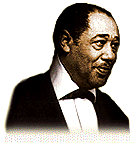
Between 1930's "Mood Indigo" and 1954's "Satin Doll," yet another aspect of Ellingtonia emerges. As a songwriter, distinct from his career as bandleader and orchestrator, Ellington gained the most in terms of spiritual and economic support for all of his other ventures, rising nearly as high in the ASCAP stakes as Cole Porter or Irving Berlin. In fact, just as in his early '20s he could have made a better living supplying bands for Washington social functions than by risking all in coming to New York, by the '40s Ellington could have built a bigger bank account by concentrating exclusively on hit songs.
But even more than the piano, the orchestra was his instrument and he was driven to keep playing it. After a decade as the resident orchestra at the most famous of all night spots, New York's Cotton Club, and then after the demise of the swing era when all but a teensy few of his fellow bandleaders threw in the touring towel Ellington could have stayed in New York and just done occasional recordings with studio men. But his ceaseless pilgrimages across the country and later the world, directly fed his compositional needs in that they gave him the instantaneous chance to hear and adjust what he had written. The recording studio was also his instrument. Starting with the rather insensitive acoustic horns of his first sessions, and continuing up through the 24-track stereo technology of the 1970s, no one better understood exactly how to prepare music for home reproduction than Ellington.

|
The quality of Ellington's music and his orchestra improved at every stage of their tandem career; his band of the 1960s was regarded by many as the greatest of all, and even after the death of Billy Strayhorn, his closest collaborator for nearly 40 years, with sublime tenacity Ellington became more productive than ever. Still, extra-musically, his path was hardly strewn with roses, as a jazz artist, and as a black man, he knew he had to be content never to receive either the academic respect of a Stravinsky or the marketplace runermations of a Lombardo.
In early 1943, New York saw the debut of two major musical milestones with Ellington's "Black Brown and Beige" (preceeded by the extended "Dimenuendo" and "Crescendo in Blue" heard here) in January and Rodgers and Hammerstein's "Oklahoma!" in March. The second was immediately and rightfully recognized as a breakthrough and a critical and commercial smash that was instantly imitated by hundreds; the no-less worthy "Black Brown and Beige" has only recently been recognized as a triumph. In 1943 it was understood by no one, least of all the jazz community, leaving the undaunted Ellington virtually alone to continue to explore long form works in the American instrumental idiom for several decades.

|
By that time, Ellington was already beginning to be recognized as a composer whose works both exemplified and transcended the best of jazz, the genre that they grew out of. In his '60s he was denied a Pulitzer Prize - which caused many members of that committee's board to resign in protest - yet he celebrated his 70th Birthday at the White House. Today, the Ellington Orchestra continues to tour and record under Duke's only child, his son Mercer, while repertory bands like New York's American Jazz Orchestra continue to play his music regularly; Ellington's music has even made inroads into the previously impenetrable realm of the symphonic repertoire. In 1988, the Smithsonian Institution acquired Ellington's own holdings of original music and announced the formation of an archive devoted to Ellingtonia; while almost every note he recorded continues to be issued and reissued all over the world, leaving, at last count, nearly 300 compact discs alone of Ellington's music.
Ellington, who described himself as "a student of Negro history" would surely have approved. "To listen to jazz without any knowledge of its history is to miss much of its charm," he once wrote. Let this current collection, as he would say, "serve as a red-carpet entrance way."